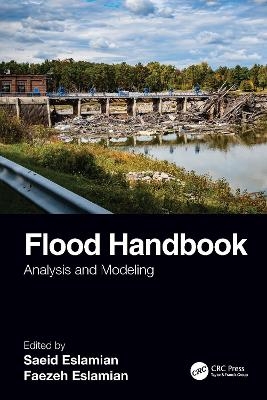
Flood Handbook
CRC Press (Verlag)
978-1-138-61476-5 (ISBN)
Floods are difficult to prevent but can be managed in order to reduce their environmental, social, cultural, and economic impacts. Flooding poses a serious threat to life and property, and therefore it’s very important that flood risks be taken into account during any planning process. This handbook presents different aspects of flooding in the context of a changing climate and across various geographical locations. Written by experts from around the world, it examines flooding in various climates and landscapes, taking into account environmental, ecological, hydrological, and geomorphic factors, and considers urban, agricultural, rangeland, forest, coastal, and desert areas.
Features:
Presents the main principles and applications of the science of floods, including engineering and technology, natural science, and sociological implications.
Considers floods in urban, agricultural, rangeland, forest, coastal, and desert areas.
Covers flood control structures as well as preparedness and response methods.
Written in a global context, by contributors from around the world.
Dr. Saeid Eslamian is professor of Hydrology at Isfahan University of Technology, where he heads the Hydrology Research Group in the Department of Water Engineering. His research focuses mainly on statistical and environmental hydrology and climate change. In particular, he is working on modeling and prediction of natural hazards including flood, drought, storms, wind, groundwater drawdown, and pollution for arid and semi-arid zones, particularly in urban areas. He is also a Visiting Professor at Princeton University, and University of ETH Zurich, Switzerland. He has contributed to more than 300 publications in books, research journals, and technical reports or papers in conferences. He is the Founder and Editor-in-Chief of both the International Journal of Hydrology Science and Technology and the Journal of Flood Engineering. He received ASCE and EWRI awards in 2009 and 2010 for his research. Faezeh Eslamian is a PhD candidate of bioresource engineering and research assistant at McGill University, Montreal, Quebec, Canada. She is currently working on the fate and transport of phosphorus through subsurface drained farmlands. Dr. Eslamian completed her bachelor’s and master’s degrees in civil and environmental engineering from Isfahan University of Technology, Iran, where she evaluated natural and low-cost absorbents for the removal of pollutants such as textile dyes and heavy metals. Furthermore, she has conducted research on the worldwide water quality standards, wastewater reuse, and drought guidelines.
Part I: An Introduction to Flooding and Human
Floods and People-Colin Green
Part II: Food Observation and Modeling Uncertainty
Importance of Hydrological and Meteorological Measurements and Observation
Flood Observation Uncertainty-Jean-François Vuillaume
Flood Modeling and Forecasting Uncertainty-Jean-François Vuillaume
Part III: Flood Modeling and Forecasting
Empirical Modelling in Design Flood Estimation-Akshay Rajan Thorvat
Flood Forecasting Time Series or Flood Frequency Analysis-Priyanka Sharma
Stable Channel Design of Tapi River Using Hec-Ras For Surat Region-Darshan J. Mehta
Hydro-Morpho Dynamics of River Junctions Characteristics and Advanced Modeling-Hydar Lafta Ali
Shallow Water Flow Modelling-Franziska Tügel
Part IV: Flood, River Restoration and Climate Change
Modelling Approach in Forecasting Changes Caused By In-Stream River Restoration Structures-Tomasz Kaluzal
Impact of Climate Change on Flooding-Conrad Wasko
Sea Level Rise Due to Climate Change- Brij Bhushan
Part V: Flood Optimization and Simulation
Real-time Operation of Reservoirs during Flood Conditions using Optimization/Simulation-Larry Mays
Application of Physically-Based Distributed Flood Models Towards Large-Scale Flood Simulations-S. Saksena
Continuous Large-scale Simulation Models in Flood Studies-Rouzbeh Nazari
Part VI: Flood Softwares
Riverine and Flood Modeling Softwares-Mustafa Goodarzi
Flood Modelling Using Open Source Software-Thomas J Scanlon
Iterative Floodway Modelling Using HEC-RAS and GIS- Majid Galoie
Flood Plain Mapping using HRC-RAS and ArcGIS-Mehdi Vafakhah
Geospatial Techniques, Flood Hazard, Vulnerability and Risk Mapping in GIS GAP-Ali Akbar Jamali
Part VII: Flood Regionalization
Determining the High Flood Risk Regions Using a Rainfall-Runoff Modeling- Iftekhar Ahmed
Geostatistics and Flooding-Homogeneous Regions Delineation for Multivariate Regional FA-E. Gargouri
Application of L moments Based Index Flood Approach: A Case Study for NSW, Ayesha Rahman
NASA Near-Real-Time Global Precipitation Products for Flood Modeling, Assessment, and Research- Zhong Liu
Part VIII: Flood Softcomputing
Real time Flood Hydrograph Predictions using Soft Computing and Rating Curve Methods- Gokmen Tayfur
Application of Integral Transforms in Hydrology-Vahid Nourani
Multi-Criteria Decision Analysis For Flood Risk Assessment-Daniel Jato-Espino
| Erscheinungsdatum | 12.04.2022 |
|---|---|
| Zusatzinfo | 85 Tables, black and white; 233 Line drawings, black and white; 26 Halftones, black and white; 259 Illustrations, black and white |
| Verlagsort | London |
| Sprache | englisch |
| Maße | 178 x 254 mm |
| Gewicht | 1075 g |
| Themenwelt | Naturwissenschaften ► Geowissenschaften ► Geologie |
| Naturwissenschaften ► Geowissenschaften ► Geophysik | |
| Naturwissenschaften ► Geowissenschaften ► Hydrologie / Ozeanografie | |
| ISBN-10 | 1-138-61476-9 / 1138614769 |
| ISBN-13 | 978-1-138-61476-5 / 9781138614765 |
| Zustand | Neuware |
| Informationen gemäß Produktsicherheitsverordnung (GPSR) | |
| Haben Sie eine Frage zum Produkt? |
aus dem Bereich


